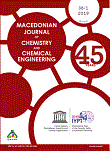Energy efficiency improvement in the system for drying baker`s yeast
DOI:
https://doi.org/10.20450/mjcce.2019.1476Keywords:
heat integration, retrofit process integration, Pinch technology, simulation,Abstract
Drying processes are one of the main consumers of heat energy in production. Any decreases in heat consumption during the drying process will considerably decrease production costs. This study analyzes the high consumption of heat in the drying of baker`s yeast. The main task is to minimize the energy demand and lower the price of the final products with partial heat recovery. These changes will require system modifications. One of the most popular and effective methods that can be used in this case is heat process integration with Pinch Technology. In this study, a reference system was simulated with a mathematical model and analyzed for waste heat streams.
This paper suggests the redesigning of a drying system for production of active dry yeast. Selected streams that satisfy conditions for heat process integration were involved in the evaluation for a better solution. Two different scenarios were proposed as possible solutions. The suggested solutions are retrofit designs of Heat Exchanger Networks. These Heat Exchanger Networks include already installed heat exchangers as well as new heat transfer units. The selection of better design was made with economic analysis of investment. The proposed scenarios of the analyzed sub-system give improvement in heat energy recovery. The best determined solution reduces the cost and thus has the highest profitability, but not the highest heat energy recovery.
References
B. Linnhoff, Pinch analysis: a state-of-art overview, Comput. Chem. Eng., 71, 503–22 (1993).
M. Türker, A. Kanarya, U. Yüzgeç, H. Kapucu, Z. Şenalp, Drying of baker’s yeast in batch fluidized bed, Chem. Eng. Process Intensif, 45, 1019–1028 (2006). DOI: 10.1016/j.cep.2006.01.016.
H. Akbari, K. Karimi, M. Lundin, M. J. Taherzadeh. Optimization of baker’s yeast drying in industrial continuous fluidized bed dryer, Food Bioprod Process, 90, 52–7 (2012). DOI: 10.1016/j.fbp.2010.12.005.
P. Sebastian, J. P. Nadeau, J. R. Puiggali. Designing dryers using heat and mass exchange networks: an application to conveyor belt dryers, Chem. Eng. Res. Des. 74, 934–43 (1996). DOI: 10.1205/026387696523102.
M. R. W. Walmsley, T. G. Walmsley, M. J. Atkins, P. J. J. Kamp, J. R. Neale, A. Chand, Carbon emissions pinch analysis for emissions reductions in the New Zealand transport sector through to 2050, Energy, 92, 569–76 (2015). DOI: 10.1016/j.energy.2015.04.069.
T. G. Walmsley, M. R. W. Walmsley, A. H. Tarighaleslami, M. J. Atkins, J. R. Neale, Integration options for solar thermal with low temperature industrial heat recovery loops, Energy, 90, 113–21 (2015).
DOI: 10.1016/j.energy.2015.05.080.
T. G. Walmsley, M. R. W. Walmsley, M. J. Atkins, J. R. Neale, A. H. Tarighaleslami, Thermo-economic optimisation of industrial milk spray dryer exhaust to inlet air heat recovery, Energy, 90, 95–104 (2015). DOI:10.1016/j.energy.2015.03.102.
T. G. Walmsley, M. J. Atkins, M. R. W. Walmsley, J. R. Neale, M. Philipp, G. Schumm et al., Total site utility systems optimisation for milk powder production, Chem. Eng. Trans., 52, 235–40 (2016).
DOI: 10.3303/CET1652040.
S. Heyne, S. Harvey, Production of synthetic natural gas from biomass-process integrated drying. ECOS 2009 - 22nd Int. Conf. Effic. Cost, Optim. Simul. Environ. Impact Energy Syst., 2009.
O. P. Arsenyeva, L. Čuček, L. L. Tovazhnyanskyy, P. O. Kapustenko, Y. A. Savchenko, S. K. Kusakov, et al., Utilisation of waste heat from exhaust gases of drying process, Front. Chem. Sci. Eng., 10, 131–8 (2016).
DOI: 10.1007/s11705-016-1560-8.
L. Sivill, P. Ahtila, Energy efficiency improvement of dryer section heat recovery systems in paper machines - A case study, Appl. Therm. Eng., 29, 3663–8 (2009).
DOI: 10.1016/j.applthermaleng.2009.06.022.
L. Sivill, P. Ahtila, M. Taimisto, Thermodynamic simulation of dryer section heat recovery in paper machines, Appl. Therm. Eng., 25, 1273–92 (2005).
DOI: 10.1016/j.applthermaleng.2004.09.002.
A. Anastasovski, P. Rašković, Z. Guzović, Design and analysis of heat recovery system in bioprocess plant, Energy Convers Manag., 104, 32–43 (2015).
DOI:10.1016/j.enconman.2015.06.081.
P. Rašković, A. Anastasovski, L. Markovska, V. Meško. Process integration in bioprocess indystry: waste heat recovery in yeast and ethyl alcohol plant, Energy, 35, 704–17, (2010). DOI:10.1016/j.energy.2009.11.020.
A. E. Kabeel, M. H. Hamed, Z. M. Omara, A. W. Kandeal. Solar air heaters: Design configurations, improvement methods and applications – A detailed review. Renew Sustain Energy Rev 2017;70:1189–206. DOI: 10.1016/J.RSER.2016.12.021.
G. Cavazzini, P. Dal Toso, Techno-economic feasibility study of the integration of a commercial small-scale ORC in a real case study, Energy Convers Manag.; 99, 161–75 (2015). DOI: 10.1016/j.enconman.2015.04.043.
I. Kemp Pinch Analysis and Process Integration (A user guide on process integration for the efficient use of energy). Oxford, Butterworth-Heinemann as imprint of Elsevier, 2007.
Munters. Munters 2017. https://www.munters.com/ en/munters/case-studies/diserod-water-pumping-station-/ (accessed May 31, 2017).
Munters. Dehumidifying Diseröd Pumping Station prevents corrosion, 2017. https://www.munters.com/en/ (accessed June 8, 2017).
J. J. Klemeš, 36 – Epilogue: The importance of problem formulation and data extraction in process integration, Handb. Process Integr., 2013, p. 1099–116.
DOI: 10.1533/9780857097255.6.1099.
T. Gundersen, 4 – Heat Integration: Targets and Heat Exchanger Network Design, Handb. Process Integr., 2013, p. 129–67. DOI:10.1533/9780857097255.2.129.
I. C. Kemp, Batch and Time-dependent Processes, Oxford, UK, Elsevier, 2007.
A. W. Westerberg. User Guide on Process Integration for the Efficient Use of Energy. : Linnhoff B., Townsend D. W., Boland D., Hewitt, G. F., Thomas B. E. A., Guy A. R. and Marsland R. H., Institution of Chemical Engineers, Geo E. Davis B, Chem. Eng. Sci., 39, 619–20 (1984).
Downloads
Published
How to Cite
Issue
Section
License
The authors agree to the following licence: Attribution-NonCommercial 4.0 International (CC BY-NC 4.0)
- Share — copy and redistribute the material in any medium or format
- Adapt — remix, transform, and build upon the material
- for any purpose, even commercially.
Under the following terms:
Attribution — You must give appropriate credit, provide a link to the license, and indicate if changes were made. You may do so in any reasonable manner, but not in any way that suggests the licensor endorses you or your use.
- NonCommercial — You may not use the material for commercial purposes.

